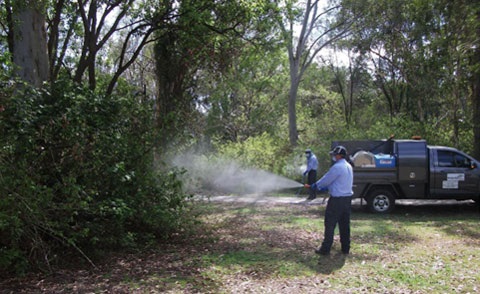Mosquito management in Moreton Bay

Mosquitoes are most active in South-East Queensland during warmer weather, from September to April.
Types of mosquitoes in Moreton Bay
Moreton Bay is home to many types of mosquitoes. The ones that cause the greatest impact on residents are:
- Saltmarsh mosquitoes. Larvae hatch in inter-tidal and mangrove areas, such as Hays Inlet, Griffin, Mango Hill, Beachmere, and Bribie Island.
- Freshwater mosquitoes. These breed in water pooled beside roads or in reserves, parks, and residents' yards after rain.
- Container breeding mosquitoes. These breed in containers of rainwater, such as plant saucers, tyres, buckets, water tanks, and blocked gutters.
Council’s mosquito management program
Council’s mosquito management program monitors and treats mosquitoes. We aim to keep their numbers as low as possible.
You can lodge a request to provide feedback on mosquitoes near you. This helps with monitoring and mapping mosquito-affected areas. You can also request more information about Council’s mosquito management.
Lodge a mosquito request
Aerial treatments
Aerial treatments target saltmarsh mosquito larvae, not adult mosquitoes. Council uses a helicopter to treat Moreton Bay's inter-tidal and mangrove areas.
Our mosquito management officers often plan aerial treatments around predicted tide events. Larvae usually develop after rain or tides higher than 2.45 metres. Often treatments coincide with those of neighbouring local government areas.
Treatment success depends on environmental factors, such as wind conditions and rain.
Parts of the following suburbs will have aerial treatments at various times from September to April:
- Beachmere
- Bribie Island
- Burpengary East
- Clontarf
- Deception Bay
- Donnybrook
- Elimbah
- Griffin
- Kippa-Ring
- Lawnton
- Mango Hill
- Ningi
- Rothwell
- Toorbul.
View a full list of completed aerial mosquito treatments.
Fogging and barrier treatments
Council uses fogging and barrier treatments in public areas such as reserves and parks. These treatments aim to reduce the impact of adult mosquitoes.
Mosquito treatment products
Council uses a range of products for the treatment of mosquitoes. The key active ingredients are:
- Bti (Bacillus thuringiensis subspecies israelensis)
- S-Methoprene
- Bifenthrin
- Phenothrin.
Bti and S-Methoprene are eco-friendly and work in aquatic environments. Council uses these products in aerial treatments targeting mosquito larvae.
Council officers use Bifenthrin for barrier spraying. Phenothrin is used for fogging.
Learn more about our mosquito management program and treatment products from Council's Mosquito management statement of intent(PDF, 2MB).
How you can reduce mosquitos around your home
You can help reduce mosquito around your home by:
- emptying any containers around the home that may contain rainwater. This includes plant saucers, tyres and buckets.
- clearing blocked gutters
- changing the water in bird baths and pet bowls regularly
- keeping your swimming pool chlorinated
- creating a frog-friendly garden
- stocking ornamental ponds and water features with fish
- checking your rainwater tank for gaps. A gap the size of a matchstick head can let mosquitoes in to lay eggs. Cover all gaps with a mosquito-proof screen or netting.
You should also consider applying mosquito repellent if outdoors at dawn or dusk.
Treatment products are available from most hardware stores to assist in reducing adult mosquito numbers around the home.
Mosquitoes and your health
Queensland Health issued an alert following cases of Japanese encephalitis virus in Queensland.
Japanese encephalitis is a disease spread through the bite of an infected mosquito to people and animals.
Find out more about Japanese encephalitis.